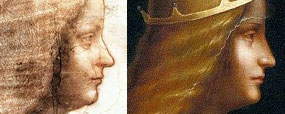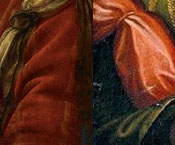Here we go again: another great masterpiece popped up out of the blue, again by a great artist (this time Leonardo da Vinci), has jumped into the headlines after Sette magazine published a few days ago, on October 4 to be exact, an article in which it practically took for granted the discovery of a portrait of Isabella d’Este that Leonardo allegedly painted and that is allegedly kept in a Swiss collection. But it was enough to observe the photograph of the portrait to immediately nurture several doubts later confirmed by many who wrote articles rejecting Leonardo’s attribution (from Tomaso Montanari even going as far as Vittorio Sgarbi, who contrary to what he did for the infamous one hundred Caravaggio drawings, this time sides against the “scoop”).
We, too, are obviously against this hasty attribution, not least because those few reasons given seem completely flimsy. For example, the “evidence” of carbon 14 examination, which would grant the work “95.4 percent probability” of having been executed between 1460 and 1650: a time span of almost two hundred years that is perfectly useless for serious analysis. Or the theory that “the imprimitura of the canvas is prepared according to the recipe written by Leonardo in his Treatise” (nothing prohibits that others could have followed the same method). However, many of those who speak out against the attribution, being art historians and not popularizers, perhaps take for granted things that instead for the general public may not be taken for granted (given many comments we have read to articles that have appeared in the online versions of major newspapers), so with this article we try to explain why the portrait of this Isabella d’Este disguised as Catherine of Alexandria (the crown and the palm of martyrdom are in fact later additions, and on this everyone agrees) cannot be by Leonardo. It is worth pointing out, however, that the first analysis one makes when trying to attribute a work of art is stylistic, that is, one tries to compare a painting with the typical features of the artist to whom one wants to attribute it in order to find similarities or differences. However, let us see for what reasons the work cannot be considered a Leonardo autograph:





These are some of the main stylistic reasons that lead us to seriously doubt Leonardo’s attribution. Then it goes without saying that no one forbids us to think that Leonardo may perhaps have been the real author of the portrait, probably under the influence of alcohol or drugs (given the final result of the painting), which would not in any case clash with the image of the genius of Vinci offered by recent television elaborations such as Da Vinci’s Demons. It would, however, take great imagination for an attribution of this kind, imagination that is indeed a great quality, but its abuse, especially in the history of art, leads to very uncomfortable results and above all can lead the discipline to lose credibility.
The author of this article: Federico Giannini e Ilaria Baratta
Gli articoli firmati Finestre sull'Arte sono scritti a quattro mani da Federico Giannini e Ilaria Baratta. Insieme abbiamo fondato Finestre sull'Arte nel 2009. Clicca qui per scoprire chi siamoWarning: the translation into English of the original Italian article was created using automatic tools. We undertake to review all articles, but we do not guarantee the total absence of inaccuracies in the translation due to the program. You can find the original by clicking on the ITA button. If you find any mistake,please contact us.